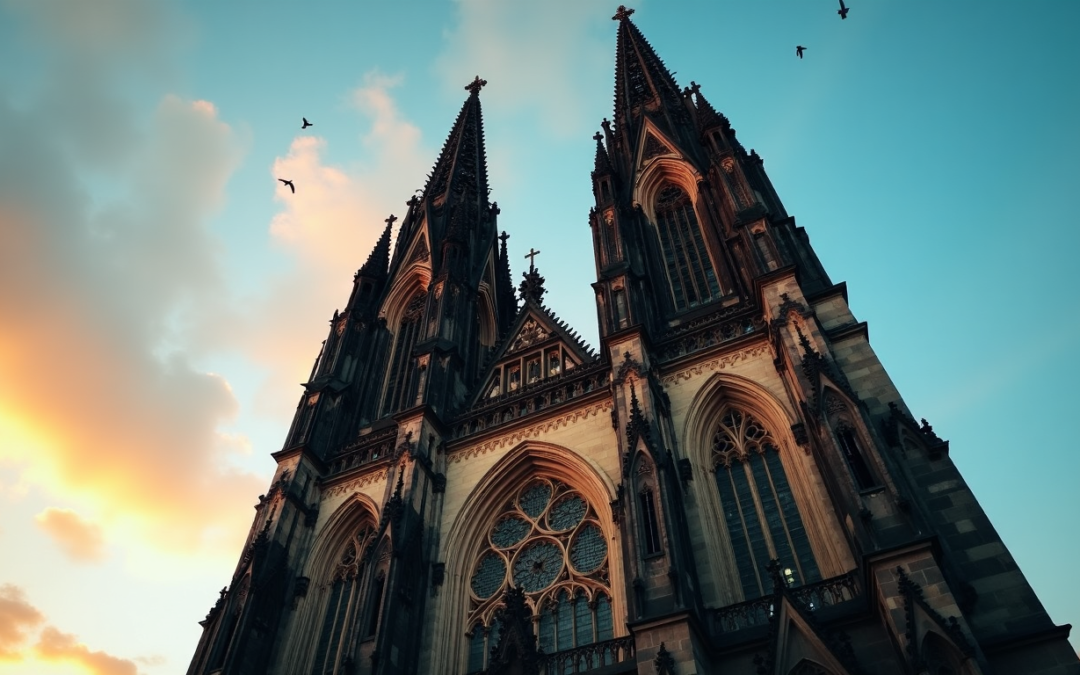Cologne Cathedral pierces the German skyline, its Gothic spires reaching 515 feet into the heavens. This architectural marvel stands proudly as Germany’s most visited landmark, drawing over 6 million people each year to gaze upon its magnificent form.
The cathedral’s story spans an astounding 632 years, from its first stone laid in 1248 to its eventual completion. Such dedication to a single vision makes it one of history’s most remarkable building projects. Today, the cathedral’s stunning presence earns it recognition as a UNESCO World Heritage site, its soaring towers and intricate stonework speaking to centuries of craftsmanship and devotion.
The cathedral welcomes visitors to explore its medieval treasures, climb its ancient towers, and wander through halls echoing with history. From the breathtaking height of its spires to the gleaming gold of its reliquaries, every corner holds something beautiful to behold.
Cologne Cathedral truly embodies the spirit of Gothic architecture at its finest. Whether bathed in morning light or silhouetted against an evening sky, this masterpiece never fails to inspire awe in those who stand before it.
The Architectural Marvel of Cologne
Cologne Cathedral stands as a masterpiece of Gothic design, stretching 144.5 meters in length and soaring 157.22 meters into the sky. This magnificent structure proudly holds its place as Europe’s second tallest church.
The cathedral’s heart beats in the shape of a Latin Cross, its design a testament to medieval ingenuity. The interior reveals stunning architectural features:
- A grand five-aisled basilica with double aisles
- A mighty transept spanning 86.25 meters
- A soaring nave reaching 43.58 meters high
- Seven beautiful radiating chapels in the eastern end
- The world’s largest church façade
Gothic elements dance throughout the cathedral’s design. Pointed arches reach skyward while ribbed vaults and flying buttresses work their engineering magic, flooding the space with natural light. These features serve both beauty and function, allowing the medieval builders to push the boundaries of what stone could achieve.
The cathedral’s construction speaks of mathematical precision. Look upward to witness one of the world’s highest Gothic vaults, its weight perfectly balanced by double aisles on each side. The medieval choir stands as a masterpiece of craftsmanship, its tall arcade and delicate triforium gallery telling tales of ancient artistry.
The true magic lies in how faithfully the 19th-century builders followed the original medieval plans. Walking through these halls today means experiencing the same vision that inspired builders over 600 years ago. Such dedication to preserving the original design helped earn the cathedral its UNESCO World Heritage status in 1996.
The stained glass windows paint stories in light and color. The Bayernfenster on the south side, gifted by Ludwig I of Bavaria, stands as a stunning example of 19th-century German artistry. These windows transform sunlight into a celestial display, bathing the interior in ever-changing hues throughout the day.
Essential Visitor’s Guide to Cologne Cathedral
The mighty cathedral welcomes visitors daily, though timing your visit needs a bit of planning. Here’s everything needed for a memorable journey through this Gothic wonder.
Best times to visit and peak hours
Early morning brings peaceful moments in these ancient halls. The cathedral opens its doors at 6 AM, though tourist hours run Monday to Saturday from 10 AM to 5 PM, and Sundays between 1 PM and 4 PM. Tourist buses rumble in after 10 AM, making early arrival the secret to a tranquil visit.
Daily masses echo through these sacred spaces throughout the week. With 20,000 souls passing through each day, quiet mid-week mornings offer the best chance to soak in the cathedral’s majesty.
Entrance fees and guided tour options
The cathedral’s main halls welcome visitors freely, though special treasures require tickets:
Tower Access:
- Adults: €8
- Children/Students: €4
- Family Ticket: €20
Treasury Visit:
- Adults: €8
- Children/Students: €4
- Family Ticket: €20 [81]
Stories come alive during guided tours, lasting 60 minutes and costing €10 for adults and €8 for children. Groups stay intimate at 20 people maximum, ensuring everyone hears the whispers of history.
Photography and behavior guidelines
These sacred stones ask for respect through simple rules:
Photography Rules:
- Capture memories without flash
- Special permission needed for tripods
- No photo shoots permitted
- Drones strictly forbidden
Dress Code and Behavior:
- Dress respectfully (no sleeveless tops or short shorts)
- Whispered voices and silent phones
- Leave food and drinks outside
- Small bags only (max size 40x35x15cm)
Luggage storage sits beside the Cathedral Shop, open daily 10 AM to 6 PM, charging €2 hourly per item. During pre-Christmas times, storage stays open until 8 PM, extending to 10 PM on Advent weekends.
Remember, while tourists flock here daily, this Gothic masterpiece remains first and foremost a house of prayer. Respectful behavior keeps the spiritual atmosphere alive within these ancient walls.
Exploring the Cathedral’s Highlights
Ancient treasures lie hidden within Cologne Cathedral’s magnificent halls. Each corner holds centuries-old wonders waiting to tell their stories.
Must-see artworks and treasures
The Shrine of the Three Kings stands as the cathedral’s crowning glory, a masterwork of medieval craft measuring 110 cm wide, 153 cm high, and 220 cm long. Golden surfaces sparkle with 304 precious gems, while inside rest what tradition calls the remains of the Biblical Magi.
The northern transept houses the remarkable Gero Cross, its oak form dating to 970 CE. This life-sized crucifix ranks among the oldest surviving north of the Alps, its naturalistic details speaking across a millennium.
Germany’s richest collection of religious treasures fills the cathedral’s Treasury. Ancient chalices and ornate monstrances still serve in sacred ceremonies today, while Roman-era fragments whisper tales of early Christian faith.
Hidden gems most visitors miss
Secret chambers stretch through 4,000 square meters beneath the cathedral floor. These mysterious spaces, once simple storage rooms, now guard precious historical archives.
Stone gargoyles perch high above, their carved faces both beautiful and practical. These often-overlooked guardians direct rainwater from ancient walls while telling tales of faith and myth in frozen stone.
Best photo spots and viewing angles
Capturing this Gothic giant demands careful planning. The finest views await at:
- Rhine Boulevard: The stairs near Hohenzollernbrücke bridge frame the cathedral perfectly
- Blue Hour: Twilight bathes cathedral, Altstadt, and bridge in magical light
- Triangle Tower: A €3 ticket unlocks breathtaking panoramas from the 28th floor
The cathedral’s sheer size defies single-frame capture. Magic lies in the details – sunbeams dancing through stained glass, casting rainbow shadows across ancient stone.
Climbing the Cathedral Towers
Ancient stone steps spiral upward through Cologne Cathedral’s south tower. This vertical journey promises stunning views for those brave enough to make the climb.
What to expect during the climb
533 steps wind their way through narrow medieval passages. The climb reaches 97 meters skyward, with no modern elevator in sight. Most visitors conquer these ancient stairs in about 15 minutes, though some speedy souls manage it in 5-7 minutes.
The bell chamber appears halfway up, home to eight magnificent bells. Here hangs the mighty Petersglocke (St. Peter’s Bell), its 24-ton mass making it the world’s largest freely swinging church bell.
Panoramic viewing platform experience
The reward for this climb? Breathtaking views stretch across Cologne’s heart, following the Rhine River’s silver ribbon. On clear days, the Siebengebirge mountains paint the horizon. The viewing platform wraps around the tower, offering stunning 300-degree views. Safety nets guard the edges, though plenty of gaps remain for perfect photos of the city below.
Tips for making the most of your tower visit
The tower welcomes climbers with these rhythms:
- March-October: 9 AM to 6 PM
- November-February: 9 AM to 4 PM
- Plan 30-45 minutes for the full experience
- Morning light paints the best pictures
- Leave backpacks behind – they’re not permitted
- Two rest stops near the top offer welcome breaks
Ancient stairs demand ancient customs – climb on the right, descend on the left. Narrow passages mean careful passing during busy times. The tower’s gates close 30 minutes before official closing time.
Insider Tips and Local Secrets
Beyond soaring spires and ancient stones, Cologne Cathedral holds secrets known only to those who walk its halls daily. These hidden treasures make this Gothic giant truly special.
Lesser-known cathedral traditions
The Domschweizer (Swiss Guard) stands as one of the cathedral’s most fascinating traditions. These guardians do far more than watch over sacred spaces – they keep ancient customs alive, guide lost souls, and collect offerings while maintaining the cathedral’s dignity. Their presence bridges centuries, connecting modern visitors to age-old traditions.
Best nearby attractions and restaurants
Delicious aromas waft through the streets around the cathedral. Local favorites include:
- Taku: Michelin stars shine over East Asian fusion in sleek modern surroundings
- Hanse Stube: French flavors dance with German traditions, all under cathedral views
- Wartesaal am Dom: Historic railway waiting room serves fresh modern dishes
Culture seekers find treasures at Museum Ludwig, merely four minutes away. The Romano-Germanic Museum stands nearby, its halls filled with ancient wonders from prehistoric times through medieval days.
Local customs and etiquette
Sacred spaces demand sacred customs. Dress modestly – no bare shoulders or short shorts. Latin Mass rings through these halls every first Sunday, welcoming worshippers from all lands.
Cameras may capture memories without flash, though remember these stones first serve prayer. Sacred rules guide visitors:
- Whispered voices and silent phones
- No earthly food or drink
- Gentle hands stay clear of ancient art
- Small bags only (55 x 40 x 20 cm)
Prayer takes precedence over tourism, though quiet observers always find welcome. Six million souls pass through yearly, making early mornings or late afternoons perfect for peaceful visits.
Surviving Through History
Stone by stone, Cologne Cathedral rose from medieval dreams to touch modern skies. Archbishop Konrad von Hochstaden laid the first stone in 1248, beginning a tale of persistence spanning centuries.
The path toward heaven twisted through time. 1322 saw the choir blessed with sacred song, but then came silence. Wars emptied coffers, and dreams slumbered. A lonely wooden crane watched over the unfinished south tower for centuries after work ceased in 1560, standing sentinel at 184 feet above the earth.
French Revolutionary troops brought horses and hay to these holy halls in the 1790s. Yet the cathedral endured. 1842 brought new hope as King Frederick William IV of Prussia commanded work to resume.
World War II tested these ancient stones most fiercely. Fourteen times Allied bombs found their mark, yet while Cologne crumbled, the cathedral stood proud. Those mighty twin spires, guiding Allied pilots through war-darkened skies, perhaps saved themselves by serving as landmarks. Through decades of healing:
- Sacred songs returned to the choir by 1948
- Interior beauty bloomed again in 1956
- War’s scars faded to memory by 2005
Today, 80 guardians tend these hallowed walls – 30 craftsmen among them, their hands joining centuries of care. Ancient wisdom meets modern tools as they battle time’s endless assault.
In 2021, modern magic captured 200,000 images by drone, weaving them into a digital tapestry of 25 billion points. Through such careful mapping, every crack and crevice reveals its secrets.
The master builder speaks truth: “Cologne Cathedral without scaffolding is not a pipe dream, but a nightmare. It would mean that we would no longer be able to afford the cathedral”. These stones live still, their story continuing through every visitor’s footsteps.

